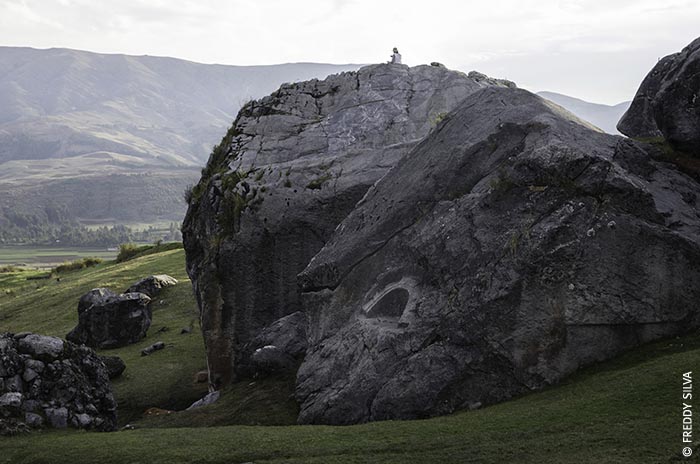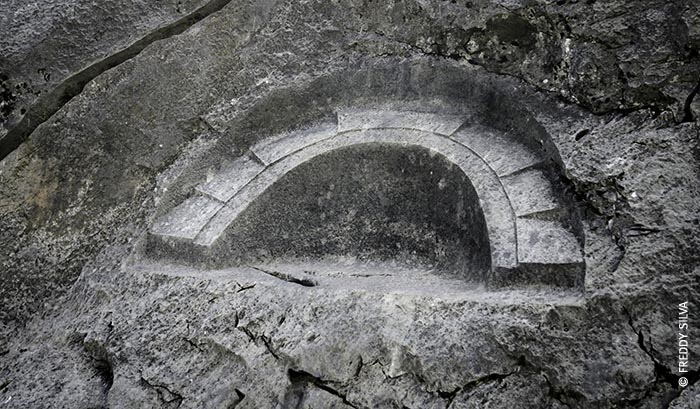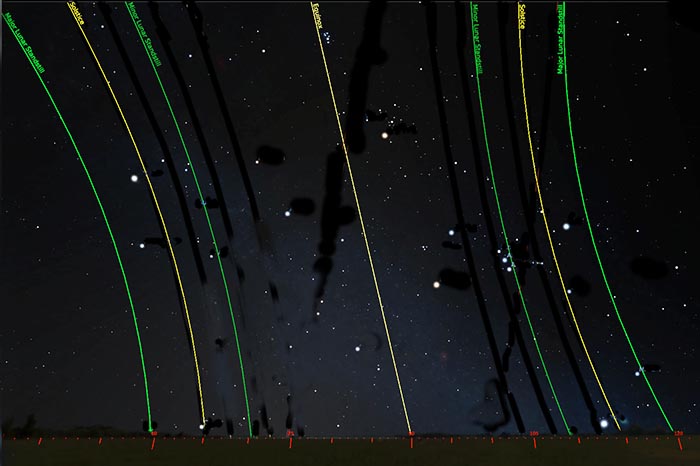THE SECRET BEHIND THE UNUSUAL
CARVED ROCK AT QUILLARUMIYOC.
The Place of the Moon Rock may be just that. And more.

Massive boulder, split in two, with the ‘Moon rock’ carving.

Massive boulder, split in two, with the ‘Moon rock’ carving.
A fifty-minute drive west of Cuzco brings you to a fertile valley and a gently sloping mountainside featuring a sprawling sacred site called Quillarumiyoc. It is a quiet and reflective spot filled with terraces, niches, altars, a sacred stream and a stepped platform, and further uphill, a cave with petroglyphs. And because it is off the beaten track it offers a place for quiet contemplation. But its most perplexing feature is a semi-circular incision cut with laser-like precision on the side of a boulder the size of a large house. The unusual symbol features a seven step motif arranged around a central bowl, angled gently upwards towards the eastern sky.
The site is often described as the Place of the Moon Rock and no one has been able to understand why. Until now.
The Andean system of sacred knowledge is centred on the principle of seven, for a number of reasons. First, it honours Viracocha and his seven Shining Ones, the Builder Gods of the Andes who rebuilt civilization after a global flood. Second, it symbolizes the Pleiades, the cluster of seven stars that are claimed by many ancient world cultures as the source of wisdom. With regard to the ‘Moon rock’, all these explanations may be true, and there may still be other levels of interpretation that lie concealled, after all, in all sacred art, symbols often conceal multiple levels of information, including a practical application. This is where the rock’s next meaning comes into its own.

The seven-step relief carving at Quillarumiyoc. Still in perfect condition after thousands of years.
It is not known when the carving was made but it can be assumed, like most other megalithic features of the Andean landscape, that it is pre-Inca, possibly Aymara, or even earlier Puquina. Certainly it appears to be referencing a feature along the eastern sky, and its 92º alignment certainly references the Equinox sunrise at this latitude.
I took the liberty of using a date of 3100 BC to run off some astronomical calculations, simply because so many important events took place in the megalithic world around this date: the erection of bluestones at Stonehenge, the start of the first ‘purely human' dynasty in Egypt (as the Edfu Texts actually describe the event), the sudden temple-building period in Sumeria, and the recently completed cycle of the Mayan and Itza calendars, to name a few.

Eastern sky after sunset at Quillarumiyoc on the summer solstice.
In this year, seven prominent trajecturies appear to match each of the carving’s seven steps: the Solstices, the Equinox, and the four major and minor standstills of the Moon at this latitude. Perhaps this is one reason why this site is referred to as Place of the Moon rock. And around 3100 BC most cultures were lunar rather than sun-based.
But there’s more.
As the Sun sets below the horizon on the summer solstice, the spine of the Milky Way can be seen ascending above the horizon, framed within the sightline of the carving. The Milky Way was regarded as the heavenly river to the Otherworld, as well as the cosmic axis, the World Tree that supports the vault of heaven — a central component of the Andean Mysteries teachings.
Also prominent at this time is the constellation of Orion, whose belt is seen ascending upright, also framed within the carving. This ‘belt’ was regarded throughout central and south America as the cosmic hearth, the birthplace of souls, and an importance source of sacred knowledge.

The three prominent stars of the Andean mythos and spine of the Milky Way.
Finally, there are three prominent stars that reflect the centre and edges of the Quillarumiyoc carving in the sky, each one central to the Andean mythos: Capella, Pleiades and Sirius.
These observations suggest that the carving of Quillarumiyoc was used as an astronomical marker as well as a teaching aid.
There still exists a rectangular megalithic section with niches for sitting, and a purification stream, adjacent to the boulder, suggesting this was once a place where the Mysteries were taught. And fundamental to these teachings was the understanding of the movement of astral bodies in relation to an orderly spiritual and material life. Not surprisingly, it is these very principles that still draw The Few to Quillarumiyoc today.
© FREDDY SILVA, 2017
Return to Megaliths